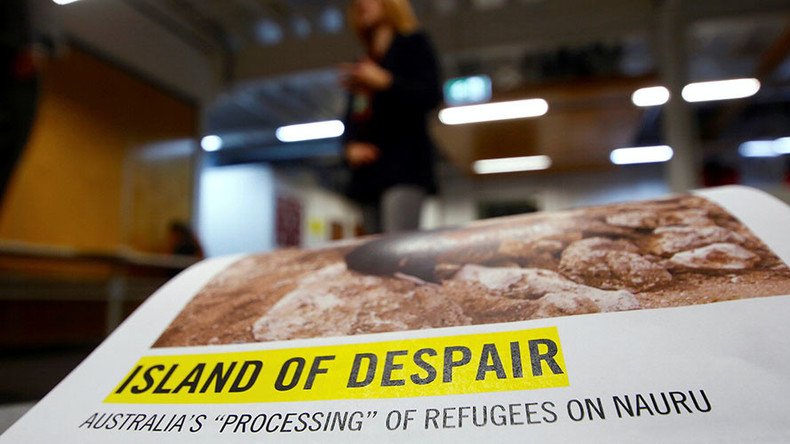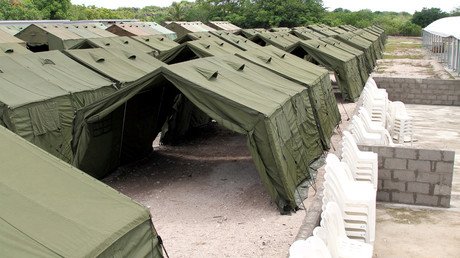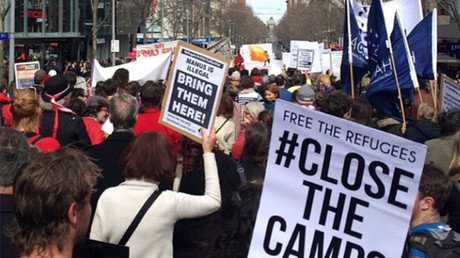Australian asylum system ‘explicitly designed to inflict damage, amounts to torture’ – Amnesty

The battle to close Australia’s brutal island-based asylum centers is set to rage even harder as Amnesty International has come out with a scathing report on the torture of refugees and the government’s complicity in deliberate torture and the purpose of its cover-up.
Australians and other countries and international institutions have all campaigned for the veil of secrecy to drop, as more compelling evidence of rampant human rights abuse kept coming in from the desolate tiny island state of Nauru. Previous reports by Amnesty and others have already detailed the scale of the misery faced by this most vulnerable group of people at the hands of their guards and the system.
Saturday’s report, entitled “Island of Despair,” deals another blow to the system that keeps the island prisons running. It reveals systematic denial of health services, coupled with physical abuse and legal and psychological intimidation carried out by staff and companies hired by the Australian government to oversee the island facility. Children are particularly at risk, and “the extent to which child refugees are subjected to abuse on Nauru is chilling,” the authors write, as they list particular cases of asylum-seeker children falling into deep psychological distress and bad health.
The organization documents numerous cases of self-harm and attempted suicides. This would often take place as a result of both treatment at the facility and the recycling of the stigma against asylum-seekers on the island, leading to their shunning by locals and peers.
According to the authors, the refugee-processing system was "explicitly designed to inflict incalculable damage on hundreds of women, men and children" in a way as to deter them. This is achieved by cordoning them off "on a remote place from which they cannot leave, with the specific intention that these people should suffer harm,” Amnesty writes.
“The conditions on Nauru – refugees’ severe mental anguish, the intentional nature of the system, and the fact that the goal of offshore processing is to intimidate or coerce people to achieve a specific outcome – amounts to torture.”
The tactics spread beyond abuse, into areas like education, where asylum-seeker children are not attending the local school is because “they’re being bullied or harassed by teachers or local children.” Amnesty says it’s documented several cases of this.
But the Nauru government is not to blame in this case, Amnesty writes. “It is the Government of Australia that set up the offshore processing system and the Government of Australia that has forcibly transferred people seeking asylum to Nauru.
A range of Australian Government officials and contractors – on Nauru and in Australia – are involved with running the Refugee Processing Centre itself and with the management of the refugee population living outside of the center. The Australian authorities are continuously informed about what is happening on Nauru.”
So it turns out that the government in Canberra remains fully appraised of the goings on at Nauru. But the policy of secrecy persists – according to the authors, as a direct result of Australian efforts to conceal the events.
Anna Neistat, Amnesty's senior director of research, who visited the island, told Fairfax Media: “It’s the intentional nature of it… "The Australian government is not even hiding the fact that the key purpose of this policy is deterrence. When you set up a system that inflicts deliberate harm as a deterrence, it's really hard to find another name for it other than torture."
The government is spending $415 million Australian dollars annually on operations, including paying the Nauru government to host its offshore immigration problem. That particular sum totals about $35.3 million per year.
To arrive at the findings, Amnesty visited the island in July for five days and matched its interviews with thousands of pages of medical reports and testimonies to police and authorities, as well as other data.
What it revealed was a system where Australia gets to publicly dump the problem on Nauru and tries to avoid accountability in the ensuing backlash. However, everything, down to the medical tests and emergency evacuations, facility, is done with Canberra’s say-so, it turns out.
"They can't authorize anything, they can't do anything, unless Canberra said 'jump'," one service company manager told Amnesty. This includes the island’s contracted healthcare provider, International Health and Medical Services. "IHMS can't do anything unless Canberra authorizes it," he added.
According to Amnesty, that’s evidence of the Australian government’s direct supervision of the facility, and results in a breach of the Convention Against Torture.
Immigration Minister Peter Dutton has said in the past he will look seriously into all allegations of rights abuse at the island, and those of self-harm. But he’s also struck out at the prospect of such things being true as “hype,” according to the Sydney Morning Herald. And the Department of Immigration and Border Protection secretary Michael Pezzullo was to release an internal report on child protection, but likewise chalked up the claims from Nauru to a cry for attention.
All of this comes after Australia has publicly denied intentionally harming refugees at Nauru.
The current report by Amnesty follows another, by the UN, released two weeks ago, and comes after a summer of rallies held at home and worldwide, campaigning for all asylum-seekers to be relocated to Australia. London and Tokyo also joined the thousands in Australia in August.















